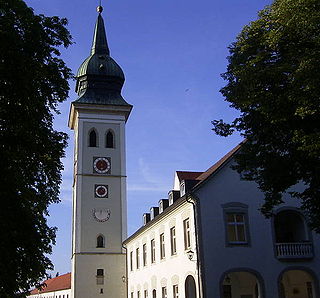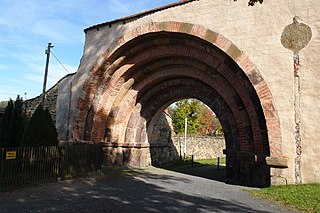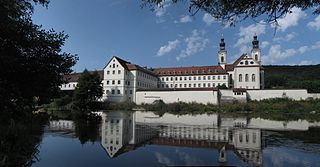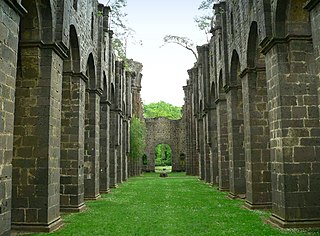
Seeon Abbey (German : Kloster Seeon) is a former Benedictine monastery in the municipality of Seeon-Seebruck in the rural district of Traunstein in Bavaria, Germany.

Seeon Abbey (German : Kloster Seeon) is a former Benedictine monastery in the municipality of Seeon-Seebruck in the rural district of Traunstein in Bavaria, Germany.
Seeon Abbey was founded in 994 by the Bavarian Pfalzgraf Aribo I, a member of the Aribonid dynasty, and settled by Benedictine monks from St. Emmeram's Abbey in Regensburg. The monastery is on an island in the lake Seeoner See , part of the present-day municipality of Seeon-Seebruck. The abbey soon developed a significant scriptorium, producing manuscripts not only for the abbey's own use but also for other monasteries and churches. Their most important client was Emperor Henry II, who presented many volumes to the Bishopric of Bamberg, which he had founded in 1007.
Toward the end of the 11th century the abbey church was re-built in the Romanesque style, but this building stood for only 100 years or so, before in about 1180 it was replaced by the present church, terminating in the east with an apse. More alterations in the late Gothic style were carried out between 1428 and 1433 by Konrad Pürkhel of Burghausen. The Romanesque basilica was given a vaulted ceiling and a new choir. In 1579 the church was decorated with unusual Renaissance frescoes, showing, alongside scenes from the life of Christ and the Virgin Mary, the patrons, Saints Benedict and Lambert, and the founders, Aribo and Adala. Also of special note is the red marble gravestone of Abbot Honorat Kolb and the gravestones of the abbots of the 15th and 16th centuries lined up against the walls of the castle chapel. In the middle stands the tomb of the founder, Count Aribo I, made by Hans Heider in about 1400. The restored cloisters are also worth seeing.
The original of the Madonna and Child (or the Seeoner Muttergottes, created in 1433 by the "Master of Seeon", as the anonymous artist is known) is considered one of the most beautiful representations of the subject. Since 1855 it has been in the Bavarian National Museum in Munich, but a copy has stood since 1947 on the high altar of the present parish church. The sacristy at Seeon contains a far older Madonna of about 1380.

The church originally had only one tower, that is, the north one, built to the model of that at Frauenchiemsee. The second tower was added at the end of the 12th century. The Romanesque towers are reminiscent of Freising Cathedral and, like the Frauenkirche at Munich, have copper "onion towers", which were added after a fire in 1561. Between 1657 and 1670 the church was extended by the construction of a sacristy in the Lady Chapel, an oratory and a crypt beneath the chapel of Saint Barbara.
Until the secularisation of Bavaria in 1803 Seeon was a place of learning and culture: Joseph Haydn was a guest here, and Mozart was active here between 1767 and 1769.
After 1803 the abbey was dissolved and the buildings were turned into a castle, and used later at various times as a medicinal spa, convalescent home and barracks. The infirmary and the library were demolished, and a causeway constructed connecting the island to the mainland.
In 1989 the premises were eventually acquired by the government of the administrative region of Oberbayern and after a lengthy restoration reopened in 1993 as a cultural and educational centre, which is now used for concerts, exhibitions, seminars, conferences and workshops.
Since 2017, the Christian Social Union's group in the German Parliament has been holding its annual retreat at Seeon Abbey. Notable guests at the retreat have since included Prime Minister Erna Solberg of Norway (2017); [1] European Commissioner Julian King (2017); Mayor of Kyiv Vitali Klitschko (2018); Prime Minister Leo Varadkar of Ireland (2019); [2] President Klaus Iohannis of Romania (2020); [3] Prime Minister Natalia Gavrilița of Moldova (2023); [4] President of the European Parliament Roberta Metsola (2023); [5] President of the European Commission Ursula von der Leyen (2024); [6] and Deputy Prime Minister Mariya Gabriel of Bulgaria (2024). [7]

Tegernsee is a town in the Miesbach district of Bavaria, Germany. It is located on the shore of Lake Tegernsee, which is 747 m (2,451 ft) above sea level. A spa town, it is surrounded by an alpine landscape of Upper Bavaria, and has an economy mainly based on tourism.

The Comburg is a former Benedictine monastery near Schwäbisch Hall, Germany.

Eberbach Abbey is a former Cistercian monastery in Eltville in the Rheingau, Germany. On account of its Romanesque and early Gothic buildings it is considered one of the most significant architectural heritage sites in Hesse.
Münsterschwarzach Abbey, is a monastery for Benedictine monks in Germany. It is located at the confluence of the rivers Schwarzach and Main in Bavaria.

Wettenhausen Abbey was an Imperial Abbey of Augustinian Canons until its secularization in 1802–1803. Being one of the 40-odd self-ruling Imperial Abbeys of the Holy Roman Empire, Wettenhaussen Abbey was a virtually independent state. Its abbot had seat and voice in the Imperial Diet, where he sat on the Bench of the Prelates of Swabia. At the time of secularization, the Abbey's territory covered 56 square kilometers and it had about 5,400 subjects.

Großheubach is a market community in the Miltenberg district in the Regierungsbezirk of Lower Franconia (Unterfranken) in Bavaria, Germany.
Roggenburg Abbey is a Premonstratensian canonry in Roggenburg near Neu-Ulm, Bavaria, in operation between 1126 and 1802, and again from its re-foundation in 1986. Since 1992 it has been a dependent priory of Windberg Abbey in Lower Bavaria. The monastery manages a training centre and a museum, and is widely known for its almost unchanged Baroque building and the organ concerts that are held in the church.

Vessra Abbey was a Premonstratensian monastery in the village also named Kloster Veßra in the district of Hildburghausen, Thuringia, Germany.

Løgum Abbey was a Cistercian monastery in the present town of Løgumkloster in North Schleswig, Denmark. In 1548, the monastery was closed down. The site is now occupied by Løgumkloster Church.

St. Burchard's Abbey was a Benedictine monastery in Würzburg, Germany, initially known as St. Andrew's Abbey. It was the first abbey established in Würzburg, founded ca. 750. In 1464, it was transformed into a Stift.

Michaelsberg Abbey or Michelsberg Abbey, also St. Michael's Abbey, Bamberg is a former Benedictine monastery in Bamberg in Bavaria, Germany. After its dissolution in 1803 the buildings were used for the almshouse Vereinigtes Katharinen- und Elisabethen-Spital, which is still there as a retirement home. The former abbey church remains in use as the Michaelskirche.

Rottenbuch Abbey in Rottenbuch was founded as an Augustinian monastery in 1073 on land granted by Duke Welf I of Bavaria and his wife Judith of Flanders. The Abbey church was constructed between 1085 and 1125 in the Romanesque style. The design of a crossing transept and free-standing tower is unusual for a Bavarian church. Rottenbuch was a center of papal loyalty during the Investiture Controversy. Under the patronage of Emperor Louis the Bavarian in the 14th century, together with its location on the pilgrimage route to Italy, Rottenbuch became the most influential house of Canons Regular in Germany.

Altzella Abbey, also Altzelle Abbey, is a former Cistercian monastery near Nossen in Saxony, Germany. The former abbey contains the tombs of the Wettin margraves of Meissen from 1190 to 1381.

Pielenhofen Abbey is a former Cistercian nunnery, in Pielenhofen in the valley of the Naab, Bavaria, Germany. It was occupied until 2010 by the Visitandines, also known as the Salesian Sisters. The Diocese of Regensburg maintains a school here.

Arnsburg Abbey is a former Cistercian monastery near Lich in the Wetterau, Hesse, Germany. It was founded by monks from Eberbach Abbey in 1174. Although heavily damaged in the Thirty Years' War it was rebuilt later in the 17th century and prospered in the 18th century, when much of the abbey was rebuilt in Baroque style.

Münchsmünster Abbey was a monastery in Münchsmünster, Upper Bavaria, in the Electorate of Bavaria. It was closed in 1556 during the Protestant Reformation, and later was administered by Jesuits and then the Knights of Malta before being auctioned in 1817 and largely demolished. Some fragments have been preserved.

Geisenfeld Abbey was a convent in Bavaria, Germany, in the town of Geisenfeld. It was founded in 1037 and dissolved in 1804. At one time it was one of the most prosperous convents in Bavaria.

Reformierte Kirche Rüti is an Evangelical Reformed church in the Swiss municipality of Rüti in the Canton of Zürich. It was built between 1214 and 1219 AD as the Romanesque style church of the then Premonstratensian Kloster Rüti, an abbey that was founded in 1206 by the House of Regensberg and suppressed in 1525 as part of the Reformation in Zürich.

The Collegiate Church of Saints Philip and James, Altötting, with the associated college or community of secular canons, was founded in about 1228 in Altötting, Bavaria, southern Germany.

The following outline is provided as an overview of and topical guide to Munich: